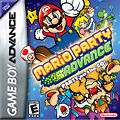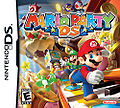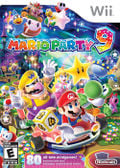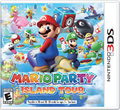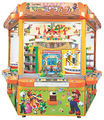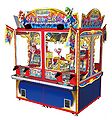Mario Party (series): Difference between revisions
(→Trivia) |
m (Trivia) |
||
| Line 692: | Line 692: | ||
*''[[Mario Party 8]]'' has the most amount of playable characters of all Mario Party games to date, with 14 (if [[Mii]] is not counted). ''[[Mario Party Advance]]'' has the least, with only four. | *''[[Mario Party 8]]'' has the most amount of playable characters of all Mario Party games to date, with 14 (if [[Mii]] is not counted). ''[[Mario Party Advance]]'' has the least, with only four. | ||
*''[[Mario Party 9]]'' is the only main game in the series (when the handheld installments aren't counted) to have a smaller amount of playable characters than its predecessor. | *''[[Mario Party 9]]'' is the only main game in the series (when the handheld installments aren't counted) to have a smaller amount of playable characters than its predecessor. | ||
*All 6 original playable characters in ''[[Mario Party]]'' and ''[[Mario Party 2]]'' have appeared in the [[Super Smash Bros. (series)|Super Smash Bros.]] games as playable characters. | |||
{{BoxTop}} | {{BoxTop}} | ||
{{Mariogames}} | {{Mariogames}} | ||
Revision as of 13:29, August 6, 2014
Template:Series-infobox The Mario Party series is a virtual board game created by Hudson Soft (Mario Party to Mario Party DS) and by Nd Cube (Mario Party 9, Mario Party: Island Tour, and Mario Party 10). It features a cast of prominent Mario series characters, some of which have been Mario, Luigi, Princess Peach, Princess Daisy, Yoshi, Donkey Kong, Wario, Waluigi, and many more with each game featuring variations on the cast and storyline. The series can be played with four players, but computer controlled players may be selected as well. All of the games share similar gameplay in which the primary objective requires the player to move his or her character across the selected stage to gather a Star. Usually, the player must then pay a fee of twenty coins to the host, a non-playable character such as Toad. After each player has completed his or her turn, a minigame then begins, in which the player may be awarded coins, based on their performance. The rules changed in Mario Party 9, where the objective is to get the most Mini Stars in boards to be the superstar.
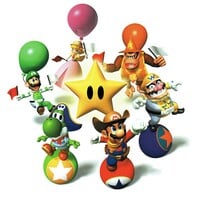
At the end of the game, Stars and Bonus Stars will be tallied. The person with the most stars at the end of the game becomes the winner, or in this case, the Superstar. If Stars are tied between players, other statistics will be applied. These include the amount of coins collected, minigame victories, and so on.
The Mario Party series amasses 13 games, across the Nintendo 64, Nintendo GameCube, and Wii consoles, as well as the Game Boy Advance, Nintendo DS, and Nintendo 3DS. The series even sports a card game that works with the e-Reader peripheral and has ported previous installments into Japan-only arcade games. The cast of characters, character cameos, and minigames are numerous. Thus far, the series has been very commercially successful, and looks to continue its success.
List of Games
| Title, Original Release and System | Synopsis |
|---|---|
| Mario Party
|
In late 1998, Nintendo released the first Mario Party game — Mario Party, for the Nintendo 64. The game was a whole new aspect on multi-player capabilities in the Mario series; most games up until now mainly featured a 2-player versus mode, with the exceptions of a few sports spin-offs. The game mechanics worked near-identically to that of a board game: players would rove around the board, moving from space to space, and hitting a Dice Block in order to move said spaces. The players could earn coins by playing and winning minigames; with a certain amount of coins, the players could buy stars. Despite the fact that this was a party game, it also had a single-player mode, in which the player would play against CPUs. There were six playable characters in the game: Mario, Luigi, Peach, Donkey Kong, Yoshi, and Wario with Toad being the host of the game. Each character had one board modeled after them, in addition to two other boards in the game — one dedicated to the game's antagonist, Bowser, and the other unlockable after collecting one-hundred stars. |
| Template:Releasedate Nintendo 64 | |
| Mario Party 2
|
The Mario Party series continued in late 1999 when Nintendo released Mario Party 2 on Nintendo 64, the sequel to the original Mario Party. The game re-used most of the mechanics of the original: players went around a board, hitting dice blocks, to reach the star space and collect it. The story, however, is different; one day, the characters decide to create their own world, which was named Mario Land. However, they soon begin to argue over a good name for the world, and, while this is going on, Bowser invades the new world, taking an area for himself. Now the characters must go through the world, to stop Bowser and take back their world. |
| Template:Releasedate Nintendo 64 | |
| Mario Party 3
|
The Mario Party series continued in late 2000 when Nintendo released Mario Party 3 on Nintendo 64, the second sequel to the original Mario Party, and the final installment on the Nintendo 64. The game re-used most of the mechanics of it's sequel: players went around a board, hitting dice blocks, to reach the star space and collect it, while using items to help along the way. The story, however, is different; every 1000 years, the Millennium star becomes reborn. This time, it crashes into the Mushroom Kingdom which alerts its residents. A nearby Lakitu transports the kingdom into a toybox and now Mario and company have to fight to get back out and to save the star from Bowser. This is the first Mario Party game to have Daisy and Waluigi as playable characters, which would also continue in future installments with the exception of Mario Party Advance. |
| Template:Releasedate Nintendo 64 | |
| Mario Party 4
|
Nintendo's first Mario Party game for the GameCube was Mario Party 4 released in 2002. The game once again re-uses the gaming mechanics of the previous installments. Toad, Koopa Troopa, Goomba, Boo, and Shy Guy discover the Party Cube, and they invite the characters to celebrate the birthday of a character. However, the five have decided that the characters should win the presents, and, pretty soon, Bowser arrives to create confusion. It is currently the latest Mario Party game to have Donkey Kong as a playable character. |
| Template:Releasedate Nintendo GameCube | |
| Mario Party 5
|
The Mario Party franchise continued in 2003 with the release of Mario Party 5. The game once again follows the same old "go around the board to collect stars" mechanics, with few changes, the most notable being the new Capsule system for items. The story involves the Star Guards wanting to invite the biggest dreamers to the Dream Depot, and they choose Mario and friends. However, Bowser and Koopa Kid want to take over the dreams and ruin them, and it's up to Mario and the gang to stop him. |
| Template:Releasedate Nintendo GameCube | |
| Mario Party 6
|
Mario Party once again returned in 2004 when Mario Party 6 was released. Unlike the past games, one thing was changed in the gaming mechanics: the inclusion of a microphone, which allowed the player to speak and play in Mic minigames. Another thing that was changed was that every 3 turns, the time of day would change from day to night, and vice versa. The two game hosts, Brighton and Twila, were friends until Brighton asked who was more impressive. This sparked the feud between the two, which Mario and friends hope to stop by collecting stars and completing the Miracle Book. |
| Template:Releasedate Nintendo GameCube | |
| Mario Party Advance
|
The first Mario Party release on a handheld console was Mario Party Advance in 2005, released on the Game Boy Advance. The game had four modes: Shroom City, Play Land, Party Land, and Challenge Land. Shroom City involves the same gaming mechanics as past Mario Party games; however, players travel around inside a car, doing odd jobs for the inhabitants of the city to obtain mini-games and Gaddgets. Play Land allows the player to play the mini-games and Gaddgets they've earned. Party Land lets the player compete to earn coins, and Challenge Land is a multi-player mode where players can compete. |
| Template:Releasedate Game Boy Advance | |
| Mario Party 7
|
Mario Party still returned when Nintendo released Mario Party 7 in November 2005, and the fourth and final installment on the Nintendo GameCube. The game once again incorporated all the mechanics from previous releases, including the microphone and mic-exclusive mini-games. However, one feature is included, which allows up to eight players to party, with two players sharing one controller. The game's story involves the gang going on a cruise around the world. However, since Bowser wasn't invited, he has decided to get his revenge, by trying to make the cruise horrible for the gang. |
| Template:Releasedate Nintendo GameCube | |
| Mario Party 8
|
Mario Party 8, is Nintendo's ninth installment in the main Mario Party series, and the first installment for the Wii, released in 2007. This game introduces three new playable characters: Miis (only playable in the Extras Zone), Blooper, and Hammer Bro., and a new host, MC Ballyhoo. This game has an assortment of new mini-games and new game boards. There are five modes in the Star Carnival: The Party Tent, where players can have a classic game of Mario Party, the Minigame Tent, where players can play mini-games, the Extras Zone, where players can play extra mini-games, the Fun Bazaar, where players can buy mini-games, items, and various other things, and the Star Battle Arena, which acts as the game's story mode. Mario and friends have been invited to the Star Carnival to party, and the winner of their game gets a year's supply of candy. However, just as one of the gang is crowned the Superstar, Bowser steals the Star Rod they were to receive, and now Mario and friends must defeat Bowser and get it back. |
| Template:Releasedate Wii | |
| Mario Party DS
|
For the first time, Nintendo developed a Mario Party game for the Nintendo DS. Mario Party DS came out a week after Super Mario Galaxy and in the same year as its indirect follow-up, Mario Party 8. In this game, five meteorites fall from the sky. The next day, Mario and the gang are discussing this when Kamek drops invitations for the Mario gang; Bowser has invited them to his castle for a banquet. However, once Mario and the gang arrive, they are captured, shrunk to a microscopic size, and thrown out of the castle. Now, they have to get back to Bowser's Castle to be restored to their normal height, helping people along the way. This game features many mini-games and it has a unique storyline compared to the other games in the series. All of the playable characters that appear appeared in Mario Party 8. About a year and a half later, Nintendo developed its sequel which is only available in Japan. |
| Template:Releasedate Nintendo DS | |
| Mario Party 9
|
Mario Party 9 is Nintendo's eleventh main installment in the Mario Party series and the second and final installment on the Wii, released in 2012. The game use a similar gameplay mechanic as Mario Party Advance in that the players move around in a vehicle. Players take turns as the captain, rolling to dice to move the vehicle. Instead of attempting to collect Coins to buy stars, the players attempt to earn the most amount of Mini Stars on each board by collecting them from the board, winning minigames, and beating bosses. They must also avoid Mini Ztars, which decrease the player's current total of Mini Stars. The game also has two boss battles integrated into each board; the players try to take down a boss together, while also trying their best to increase their individual scores. The game's story first involves Mario and friends looking at the night sky when they suddenly see Mini Stars being sucked into a vortex; the ones behind this are Bowser and Bowser Jr.. Mario and friends then head off to save the Mini Stars by defeating Bowser. The game is developed by Nd Cube, and is the first in the series to not be developed by Hudson. |
| Template:Releasedate Wii | |
| Mario Party: Island Tour
|
Mario Party: Island Tour is the twelfth installment in the main Mario Party series and is released for the Nintendo 3DS. This is the second Mario Party installment to be developed by Nd Cube. The game returns to the traditional individual player movement of the Mario Party franchise, but each board has its own unique style of gameplay. |
| Template:Releasedate Nintendo 3DS | |
| Mario Party 10
|
Mario Party 10 is the first Mario Party game for the Wii U, and the thirteen game in the main Mario Party series set to release in 2015. The game reuses the vehicle mechanic, and players once again, players have the goal of collecting Mini Stars. However, in addition to the traditional Party Mode, a new mode called Bowser Party has also been confirmed. In this mode, a player using the GamePad plays as Bowser, while the other players play as the heroes. |
| TBA 2015 Wii U |
- Arcade
Boards
The Mario Party series included many boards in various installments. Below is a list of all of them and what games they appear in.
| Theme | MP | MP2 | MP3 | MP4 | MP5 | MP6 | MP7 | MP8 | MP9 | MPDS | MPIT | MP10 |
|---|---|---|---|---|---|---|---|---|---|---|---|---|
| Cake | ||||||||||||
| Casino | ||||||||||||
| Castle | ||||||||||||
| Cavern | ||||||||||||
| Cloudy Sky | ||||||||||||
| Desert | ||||||||||||
| Factory | ||||||||||||
| Forest | ||||||||||||
| Horror | ||||||||||||
| Island | ||||||||||||
| Jungle | ||||||||||||
| Library | ||||||||||||
| Music | ||||||||||||
| Park | ||||||||||||
| Peak | ||||||||||||
| Railway | ||||||||||||
| Rainbow | ||||||||||||
| Ship | ||||||||||||
| Snowfield | ||||||||||||
| Space | ||||||||||||
| Town | ||||||||||||
| Underwater | ||||||||||||
| Volcanic |
Mario Party
- This game has 8 boards
- Cake - Peach's Birthday Cake
- Castle - Mario's Rainbow Castle
- Factory - Luigi's Engine Room
- Island - Yoshi's Tropical Island
- Jungle - DK's Jungle Adventure
- Canyon - Wario's Battle Canyon
- Space - Eternal Star (Unlockable)
- Volcano - Bowser's Magma Mountain (Unlockable)
Mario Party 2
- This game has 6 boards
- Desert - Mystery Land
- Forest - Horror Land
- Park - Bowser Land (Unlockable)
- Ship - Pirate Land
- Space - Space Land
- Town - Western Land
Mario Party 3
- This game has 6 boards
- Cavern - Creepy Cavern
- Desert - Spiny Desert
- Forest - Woody Woods
- Island - Waluigi's Island (Unlockable)
- Snowfield - Chilly Waters
- Underwater - Deep Bloober Sea
Mario Party 4
- This game has 6 boards
- Casino - Goomba's Greedy Gala
- Horror - Boo's Haunted Bash
- Island - Koopa's Seaside Soiree
- Jungle - Shy Guy's Jungle Jam
- Park - Toad's Midway Madness
- Volcano - Bowser's Gnarly Party (Unlockable)
Mario Party 5
This game has 7 boards
- Cake - Sweet Dream
- Castle - Rainbow Dream
- Cloudy Sky - Rainbow Dream
- Park - Toy Dream
- Peak - Pirate Dream
- Ship - Pirate Dream
- Space - Future Dream
- Underwater - Undersea Dream
- Volcanic - Bowser Nightmare (Unlockable)
Mario Party 6
- This game has 9 boards (6 in party mode and 3 in solo mode)
- Castle - Clockwork Castle, Infernal Tower (Solo)
- Desert - Thirsty Gulch (Solo)
- Factory - E. Gadd's Garage
- Forest - Towering Treetop
- Island - Castaway Bay
- Snowfield - Snowflake Lake
- Space - Astro Avenue (Solo)
- Town - Faire Square
- Volcano - Infernal Tower (Solo)
Mario Party 7
- This game has 6 boards
- Desert - Pyramid Park
- Forest - Windmillville
- Park - Bowser's Enchanted Inferno! (Unlockable)
- Peak - Pagoda Peak
- Ship - Grand Canal
- Town - Grand Canal, Neon Heights
- Volcanic - Bowser's Enchanted Inferno! (Unlockable)
Mario Party 8
- This game has 6 boards
- Jungle - DK's Treetop Temple
- Island - Goomba's Booty Boardwalk
- Horror - King Boo's Haunted Hideaway
- Railway - Shy Guy's Perplex Express
- Space - Bowser's Warped Orbit (Unlockable)
- Town - Koopa's Tycoon Town
Mario Party 9
- This game has 7 boards
- Castle - Boo's Horror Castle
- Casino - Bowser Station (Unlockable)
- Cavern - Magma Mine
- Factory - Bob-omb Factory
- Forest - Toad Road
- Horror - Boo's Horror Castle
- Island - Blooper Beach
- Jungle - DK's Jungle Ruins (Unlockable)
- Railway - Magma Mine
- Space - Bowser Station (Unlockable)
- Underwater - Blooper Beach
- Volcanic - Magma Mine
Mario Party 10
- Park - unnamed board
- Cloudy Sky - unnamed board
Mario Party DS
- This game has 5 boards
- Casino - Bowser's Pinball Machine (Unlockable)
- Forest - Wiggler's Garden
- Jungle - DK's Stone Statue
- Library - Kamek's Library
- Music - Toadette's Music Room
Mario Party: Island Tour
- This game has seven boards
- Forest - Perilous Palace Path
- Peak - Banzai Bill's Mad Mountain
- Cloudy Sky - Star-Crossed Skyway
- Space - Rocket Road
- Horror - Kamek's Carpet Ride
- Library - Kamek's Carpet Ride
- Casino - Shy Guy's Shuffle City
- Volcanic - Bowser's Peculiar Peak (Unlockable)
Playable Characters
Playable characters are introduced in the first Mario Party. During the first two Mario Party games, Mario, Luigi, Princess Peach, Wario, Yoshi, and Donkey Kong are the only playable characters in the series. Starting in Mario Party 3, the game introduces new playable characters in debut such as Princess Daisy and Waluigi, the new playable characters are only playable in the Party Mode; the previous new characters that appear in the next game are now playable in the Story Mode. There are some exceptions in games like Mario Party Advance and Mario Party DS do not introduce new characters.
There are some exceptions of removing playable characters in later main games; Donkey Kong is removed starting in Mario Party 5 because he now owns a space called a DK Space which he hosts, although Donkey Kong is playable in the Special Duel Mode in Mario Party 5 and is replaced by Toad. Another playable character named Koopa Kid (Mini Bowser in PAL regions) appeared in Mario Party 5 and Mario Party 6; he was removed after the last appearance because he now owns a space called the Koopa Kid Space. In Mario Party 9, Boo, Dry Bones, Blooper, and Hammer Bro were removed and given supporting roles. Toadette was also removed, and was completely absent from the game and was also absent in Mario Party: Island Tour. However, Boo returned in Mario Party: Island Tour as a playable character, and is the only character to do so making Mario, Luigi, Princess Peach, Wario, Yoshi, Princess Daisy, Waluigi, and Toad the only eight playable characters to never be removed in later main games.
In the game Beach Volley Folley that appeared in Mario Party 4 and then Mario Party 5, there are exceptionally playable characters that can not be played as on the normal boards but are able to participate in this game.
The Mario Party series included many characters in various installments. Below is a list of all of them and what games they appear in.
| Character | MP | MP2 | MP3 | MP4 | MP5 | MP6 | MP7 | MP8 | MP9 | MPA | MPDS | MPIT | MP10 |
|---|---|---|---|---|---|---|---|---|---|---|---|---|---|
| Birdo | |||||||||||||
| Blooper | |||||||||||||
| Boo | |||||||||||||
| Bowser | |||||||||||||
| Bowser Jr. | |||||||||||||
| Princess Daisy | |||||||||||||
| Donkey Kong | |||||||||||||
| Dry Bones | |||||||||||||
| Hammer Bro. | |||||||||||||
| Kamek | |||||||||||||
| Koopa Kid | |||||||||||||
| Koopa Troopa | |||||||||||||
| Luigi | |||||||||||||
| Mario | |||||||||||||
| Mii | |||||||||||||
| Princess Peach | |||||||||||||
| Shy Guy | |||||||||||||
| Toad | |||||||||||||
| Toadette | |||||||||||||
| Waluigi | |||||||||||||
| Wario | |||||||||||||
| Yoshi |
– Playable character
– Non-playable character
– Unknown status
- 1 — The character is playable only in Beach Volley Folley.
- 2 — The character is playable only in Super Duel Mode.
- 3 — The character is only playable in Party Mode.
- 4 — The character is playable only in the Extra Mode.
- 5 — The character is only playable in Bowser Party.
- 6 — The character is unlockable.
Hosts
These characters lead each individual Mario Party game.
- Mario Party: Toad and Koopa Troopa
- Mario Party 2: Toad and Koopa Kid (only in Bowser Land)
- Mario Party 3: Tumble and Millennium Star
- Mario Party 4: Toad, Shy Guy, Boo, Koopa Troopa, Goomba, Koopa Kid, Thwomp (only in Extras Mode), Whomp (only in Extras Mode), and Ztar (only in Beach Volley Folley)
- Mario Party 5: Star Spirits
- Mario Party 6: Brighton and Twila
- Mario Party Advance: Toad, Toadette, Tumble, and Professor E. Gadd
- Mario Party 7: Toadsworth
- Mario Party 8: MC Ballyhoo & Big Top
- Mario Party DS Wiggler, Toadette, Diddy Kong, Kamek and Bowser.
- Mario Party 9: Yellow Toad (Party, Solo, and Museum) and Blue Toad (Minigames and Extras)
- Mario Party: Island Tour: Yellow Toad (Party), Bowser (only in Bowser's Peculiar Peak and Bowser's Tower), Blue Toad (Minigames, StreetPass Minigames, and Collectables), and Green Toad (Bowser's Tower)
Spaces
- Main article: Space (Mario Party series)
All the spaces in the Mario Party games.
Items
Every item, capsule, orb, candy, hex and card from the series.
List of All Minigames
The Mario Party series' popularity is due in no small part to its minigames. Throughout the series' nine console titles, the list of minigames has become tremendous. Below is a list of all 769 minigames, separated by game. The minigames' titles generally rhyme, use alliteration, or are puns of popular phrases.
Awards
- Longest Running Mini-Game Series - Guinness Book of World Records Gamer's Edition 2009 - 2013
Trivia
- Luigi mentions the Mario Party series in his diary in the events of Paper Mario.
- The Mario Party games are mentioned in one of the Coin Block/Brick Block cards in Nintendo Monopoly. Here, the player gets $50 from every player for organizing a Mario Party in the 2006 version, and $10 in the 2010 version.
- Mario Party 8 has the most amount of playable characters of all Mario Party games to date, with 14 (if Mii is not counted). Mario Party Advance has the least, with only four.
- Mario Party 9 is the only main game in the series (when the handheld installments aren't counted) to have a smaller amount of playable characters than its predecessor.
- All 6 original playable characters in Mario Party and Mario Party 2 have appeared in the Super Smash Bros. games as playable characters.

